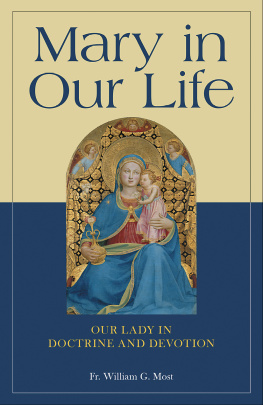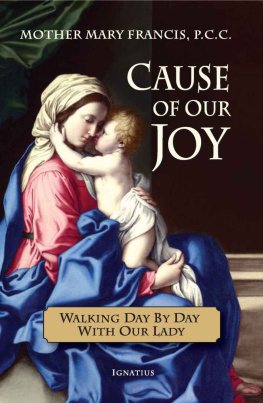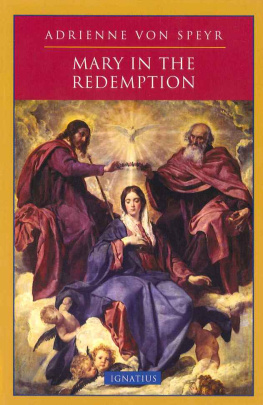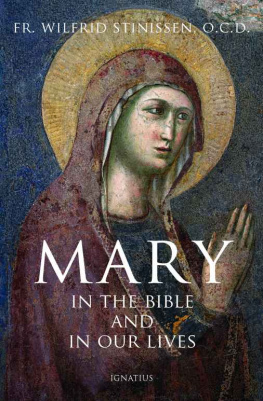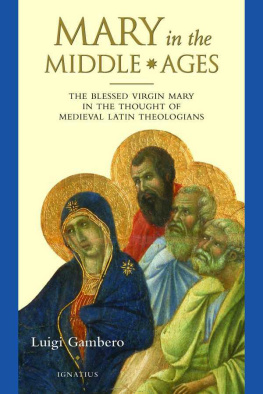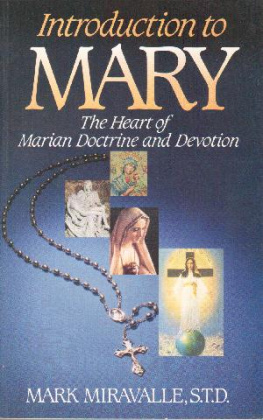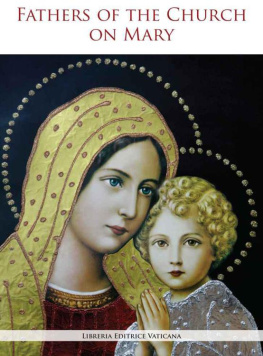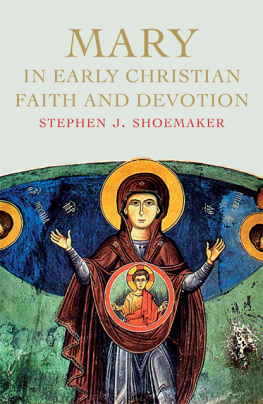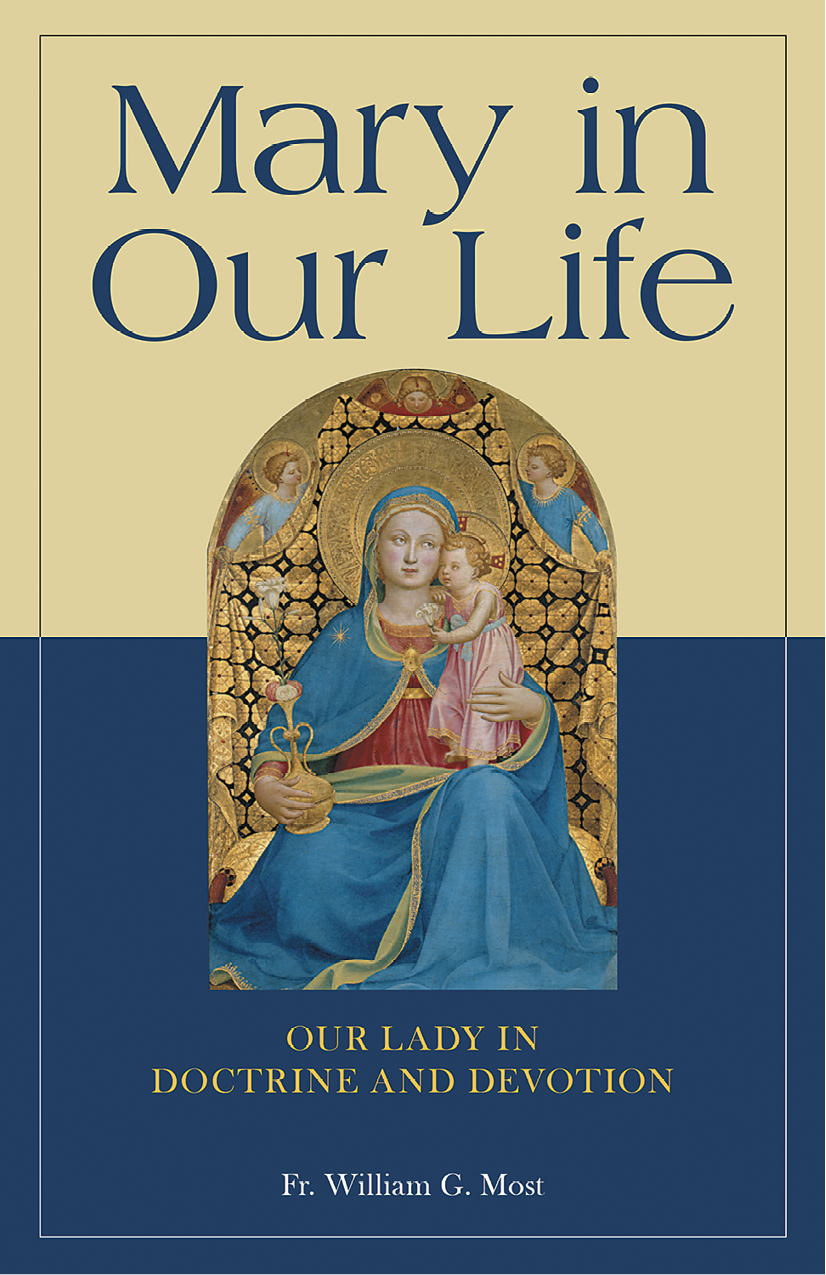Nihil Obstat: Ernestus P. Ament,
Censor Deputatus
Imprimatur : + Leo Binz,
Archiepiscopus Dubuquensis
Die 9 Aprilis 1959
Library of Congress Cataloging-in-Publication Data
Most, William G. (William George), 1914-1999. Mary in our life. New York,
P. J. Kenedy [1954]
xviii p., 323 p. 21 cm.
BT640 .M6
Cover image: Virgin of Humility by Fra Angelico
Reprinted in 2014 by Angelus Press
All rights reserved. First edition 1937.
Third edition 1959.
Angelus Press
Forest Avenue
Kansas City, Missouri 64109
Phone (816) 753-3150
FAX (816) 753-3557
Order Line 1-800-966-7337
www.angeluspress.org
ISBN 978-1-937843-57-1
FIRST PRINTINGSeptember 2014
Printed in the United States of America
To the Sacred Heart of Jesus
Through the Immaculate Heart of Mary
That Their Kingdom May Come
In the Hearts of All Men
Prayer of Pope Pius XII
Composed for the Marian Year, 1954
ENRAPTURED by the splendor of your heavenly beauty and impelled by the anxieties of the world, we cast ourselves into your arms, O Immaculate Mother of Jesus and our Mother, Mary, confident of finding in your most loving heart appeasement of our ardent desires and a safe harbor from the tempests which beset us on every side.
THOUGH degraded by our faults and overwhelmed by infinite misery, we admire and praise the peerless richness of sublime gifts with which God has filled you, above every other mere creature, from the first moment of your Conception until the day on which, after your Assumption into heaven, He crowned you Queen of the Universe.
O CRYSTAL Fountain of faith, bathe our minds with the eternal truths! O fragrant Lily of all holiness, captivate our hearts with your heavenly perfume! O Conqueress of evil and death, inspire in us a deep horror of sin, which makes the soul detestable to God and a slave of hell!
O WELL-BELOVED of God, hear the ardent cry which rises up from every heart in this year dedicated to you. Bend tenderly over our aching wounds. Convert the wicked, dry the tears of the afflicted and oppressed, comfort the poor and humble, quench hatreds, sweeten harshness, safeguard the flower of purity in youth, protect the holy Church, make all men feel the attraction of Christian goodness. In your name, resounding harmoniously in heaven, may they recognize that they are brothers and that the nations are members of one family, upon which may there shine forth the sun of a universal and sincere peace.
RECEIVE, O most sweet Mother, our humble supplications, and above all obtain for us that, one day, happy with you, we may repeat before your throne that hymn which today is sung on earth around your altars: You are all beautiful, O Mary! You are the glory, you are the joy, you are the honor of our people! Amen.
Preface
The theme of this book can be summed up in one sentence: God has given to Mary an all-pervading place in the work of the Redemption; therefore, if we wish to imitate the ways of God as perfectly as possible, we should give her a corresponding place in our spiritual lives.
We are going to study both aspects of that theme: the dogmas that show Marys place in the plans of God, and the means by which we can make our lives harmonize with Gods plans. For doctrine and devotion are closely interrelated. Our devotion must be solidly grounded on the firm rock of dogma; otherwise devotion will be shallow. But knowledge of dogma should deepen devotion; otherwise we may become hard. In our Introduction we present the deeper reasons why devotion should flow from doctrine, so that the reader may gain the maximum profit from this book.
The two aspects of our theme indicate the twofold division of the book. The first part (chapters IVIII) analyzes Marys place in the Redemption, from the first promise of the Redeemer in paradise to her role in the second coming of Christ at the end of the world. This dogmatic section rests chiefly on a careful analysis of the most recent papal statements on Marys place in the entire scheme of the Redemption. The major emphasis and attention are given to those truths that are most intimately related to the development of a sound Marian spirituality .
Now, if Mary is to pervade all our spiritual life, we should not be satisfied merely with certain prayers or particular devotional exercises in her honor: we should bring her influence into the most basic structure of our spiritual life. For this reason, the second section opens with a group of seven chapters on the general principles of the spiritual life, explained in such a way as to show how Mary is our model and constant companion and helper. These chapters draw chiefly on the works of St. Thomas Aquinas, St. Francis de Sales, St. John of the Cross, St. Teresa of Avila, St. Thrse of Lisieux, and St. Louis de Montfort; the best works of modern theologians are also utilized. In these chapters we discover the very essence of spiritual growthgrowth in love of God and neighbor. We study the principal virtues that make room for love: humility and mortification. We examine the nature and the normal stages in the development of mental prayer, from the meditation of beginners up to the first forms of mystical infused prayer. After this we discuss the great means of gracethe Mass and the Sacraments, and Marys relation to them (XVIXVII). We then study total consecration to Mary, a great means that in itself is a synthesis of all other means (XVIII): if a soul lives out its consecration perfectly, it will be more and more guided and moved by the Holy Spirit, whose Spouse Mary is (XIX). But devotion to Mary is meant to lead us through her Immaculate Heart to the Sacred Heart of her Son; therefore chapter XX treats the relation between these two Hearts in our devotion. We then consider certain outward aspects of devotion to Mary: her recent apparitions, and the classic Marian devotions of the Rosary and the Scapular (XXIXXII). The final chapter (XXIII) completes the program with some specific suggestions for forming a private Marian rule of life.
Readers in France, Germany, Spain, and Italy today are able to obtain precise and thorough information about Mariology from many works in their native languages. Now, while there are many excellent books about Mary in English, few of them set out to give the reader a precise, documented study. While the pronouncements emanating from the Holy See over the past century have been numerous and rich, most American readers have heard of little more than the definition of the Assumption. Hence this book aims in a very modest way to help make more readily available to American readers some part of what readers in many other nations already possess. It is designed, therefore, for anyone who desires to have theologically exact, documented information presented in language that he can understand even though he has not had the advantage of formal courses in philosophy and theology.
Again, many writers, after offering a detailed presentation of basic spiritual principles and their applications, urge us to give Mary a large place in our personal spiritual lives. But it is not too easy to find works that actually show in detail and in a practical fashion how this can be done, how to bring Marys influence into the basic structure of our spiritual lives. The second part attempts to fill that need to some extent. In the course of that part, many difficult but practical problems are faced and a solution is attempted. Therefore it is hoped that the book will be helpful to the many good people today who sincerely want to grow spiritually, but who do not know precisely how to go about it.

